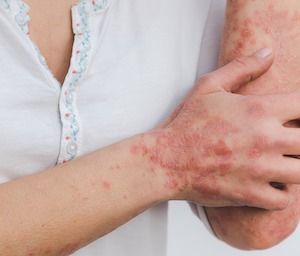Article
Guselkumab Linked to Improved Psoriatic Arthritis Outcomes in Phase 3b Trial
Author(s):
Data show 57.7% of patients achieved ≥20% improvement in joint symptoms and 53.4% achieved complete skin clearance at 1 year.

New data presented at EULAR 2021 show guselkumab (TREMFYA) met safety and efficacy outcomes for patients with psoriatic arthritis (PsA).
The COSMOS Phase 3b show 57.7% of patients achieved ≥20% improvement in joint symptoms and 53.4% achieved complete skin clearance at 1 year in the COSMOS study.
The study included the first selective interleukin (IL)-23 inhibitor in a true TNFi-IR patient population.
Guselkumab is a monoclonal antibody that selectively binds to the p19 subunit of IL-23 and inhibits its interaction with the IL-23 receptor.
Study
Data from COSMOS show that 44.4% of patients who received guselkumab versus 19.8% of patients who received placebo achieved a ≥20% improvement in the American College of Rheumatology criteria (ACR20) at week 24, meeting the primary endpoint.
Further, guselkumab was found superior in patients achieving ACR50 and improvement in physical function and general health outcomes.
Mean improvement in physical function improved at 1 year, leading to higher resolution rates of enthesitis and dactylitis.
The results also found at week 24, patients with ≥3% body surface area prsoriatic involvement and Investigator’s Global Assessment (IGA) score ≥2 at baseline achiving complete skin clearance was significantly higher in patients receiving guselkumab.
Data also show a score of 30.8% in patients receiving guselkumab in comparison to 3.8% in patients receiving placebo.
Other studies, including the DISCOVER-1 and -2 PsA trial, show guselkumab had high response rates at week 24 for joint symptoms, skin clearance, improved physical function and enthesitis and dactylitis resolution through two years.
Reaction
Alyssa Johnsen, M.D., Ph.D., Vice President and Rheumatology Disease Area Leader, Janssen Research & Development said in a statement that the severity of skin and joint symptoms of active PsA have associations with adverse life events.
“People with PsA live with joint, skin, and soft tissue symptoms, but also experience impacts on physical function and social and psychological well-being,” Johnsen said. “We are committed to continuing our research in PsA to advance therapeutic options that may help more patients reach their treatment goals."
Laure Gossec, M.D., Ph.D., Professor of Rheumatology in Pitie-Salpetriere Hospital and Pierre & Marie Curie University and investigator in the study noted that the potential severity of PsA in patients makes safe, effective treatment a challenge.
“In particular, patients may either not respond well to TNFi, or respond but have a loss of response over time," Gossec said. "These COSMOS data reinforce TREMFYA as a therapeutic option with an alternative mechanism of action for adult patients with PsA when their disease management is complex because they have not responded to one or more therapies."
Further research will include the APEX Phase 3b trial later this year.
The trial is a long-term, 3-year extension to assess efficacy of guselkumab on the inhibition of radiographic progression of joint structural damage in patients with active PsA.





